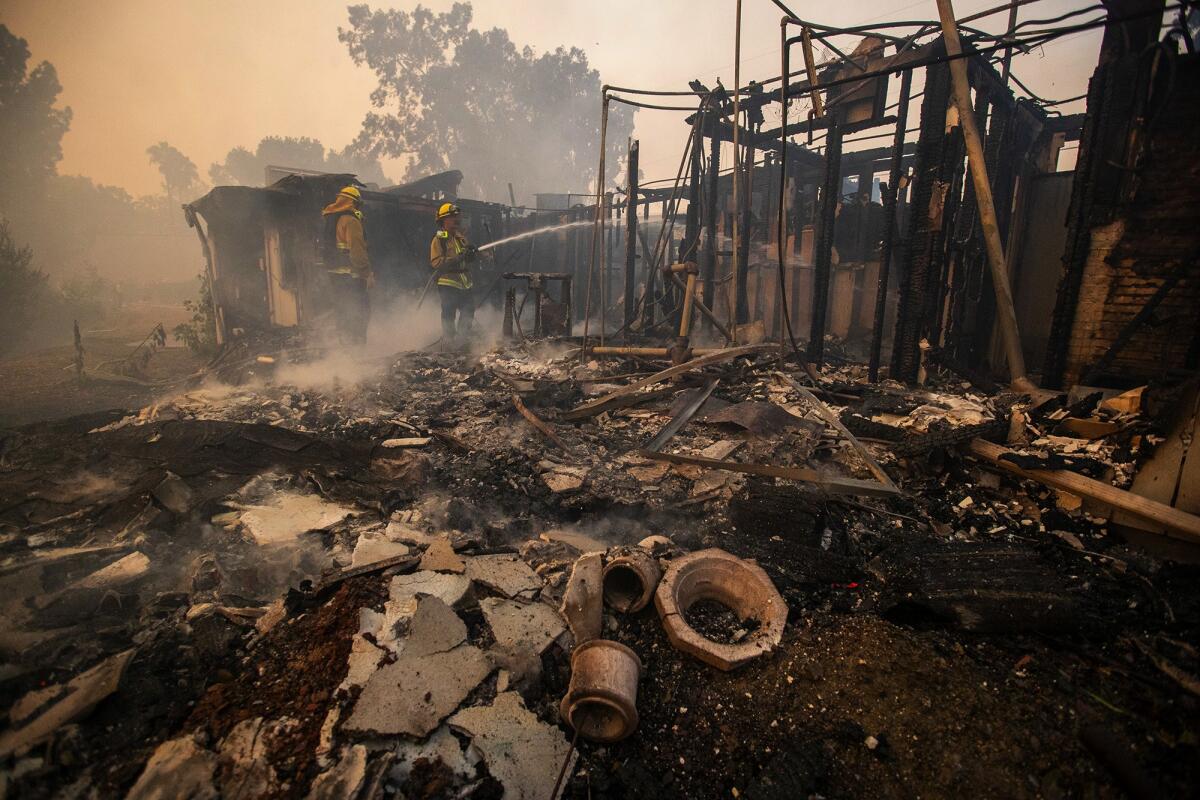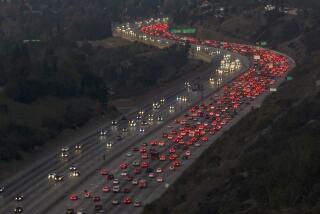Column: California fires will result in higher insurance rates for homeowners

Vida Hamadani was hit twice this week by the Getty fire. As a Brentwood resident, she was forced to evacuate from her house and move in with her son.
As an independent insurance broker, she’s been fielding calls from clients asking what’s going to happen to their rates.
“It’s not good,” Hamadani, 67, told me. “I tell them rates are going to skyrocket. I have a lot of unhappy clients.”
This year’s fire damage to California properties has been modest compared to last year’s catastrophic loss of nearly 19,000 homes, resulting in more than $12 billion in insurance claims.
But the trend is clear: Things aren’t getting any better — and thanks to climate change and our eagerness to build in areas susceptible to wildfire, the situation almost certainly will grow worse. That means the cost to homeowners for coverage will keep rising.
Mark Sektnan, vice president of the American Property Casualty Insurance Assn., didn’t want to say that so bluntly, regardless of how many time I rephrased the question.
But he acknowledged that, for many homeowners, rates are going up. In some cases, that can mean a doubling or even a tripling of premiums.
“Insurers will continue to reflect risk in their rates,” Sektnan said. “As risk increases, so will rates.”
He noted that “we’ve had three historically bad years for wildfires. Rates going forward have to reflect past losses.”
Michael Soller, a spokesman for the state Department of Insurance, said his office has heard reports of rates tripling for some homeowners. “We’re really concerned about that,” he said.
In July, Gov. Gavin Newsom signed into law a bill — AB 1054 — that creates a fund of at least $21 billion to address wildfire costs. “The rise in catastrophic wildfires fueled by climate change is a direct threat to Californians,” he said at the time.
Most of that cash will be used to assist utilities in dealing with claims related to blazes started by their equipment. That may keep utility rates from soaring, but will do little for insurance premiums.
The cost of coverage is rising not just because fire danger statewide is growing but also because some insurers have stopped writing new homeowner policies, especially in high-risk areas, such as canyons.
“Companies are constantly trying to understand what their risk is,” Sektnan said.
And they’re acting accordingly. That’s understandable from a business perspective. And bad news for people whose homes may be in harm’s way.
One proposal making the rounds is rate reductions for homeowners who take steps to mitigate fire danger, such as clearing brush around their property. This is the same basic idea as lowering health-insurance costs for people who don’t smoke or drink, or who exercise regularly.
Consumer Watchdog, a Los Angeles advocacy group, wrote an open letter to state Insurance Commissioner Ricardo Lara in August calling on him to crack down on runaway rates.
“Homeowners insurance companies are imposing extreme rate hikes and abruptly non-renewing homeowners who live in areas at higher risk for wildfires, even when they do everything in their power to mitigate fire hazards and harden their homes,” said Carmen Balber, the group’s executive director.
“Homeowners should not lose the ability to insure their homes when they do all the right things to protect themselves and their property from fires,” she said.
Lara, the insurance commissioner, told me he’s “working on solutions to address the crisis of rising insurance costs and policy non-renewals.” He added that “we need the Legislature to engage with us.”
Homeowners in high-risk areas who can’t find coverage on the open market may have to turn to a state-sponsored program called the California FAIR plan. FAIR covers up to $1.5 million for a structure and its contents, which in some cases won’t be enough for full replacement of a lost home and property.
Sektnan said there’s been an uptick in the number of people turning to the FAIR plan. But he said many people stay in the program for just a few months, until they can find more comprehensive coverage elsewhere.
If nothing else, the current fires serve as a reminder for all California homeowners to make sure their coverage is up to date. Contact your insurance agent to confirm that the estimated replacement cost for your house reflects current market conditions.
Pro tip: Ask about whether you’re covered not just for fire damage but also for damage caused by smoke or ash blowing from elsewhere. Some insurers deny such claims.
You might also consider paying a little more for what’s known as an extended replacement cost endorsement. This is an add-on to your policy that will cover at least a portion of unexpected cost increases in the event you have to rebuild.
It’s a near-certainty that labor costs, as well as prices for materials such as wood and cement, will surge after a devastating blaze.
You can also purchase additional coverage for code upgrades — for example, if the rules have changed for electrical systems, plumbing or insulation since your house was built. Such “betterments,” in insurance lingo, might not be covered by your existing policy.
Whether you’re a homeowner or a renter, take your smartphone and walk around your home shooting a video of your belongings. This can be very helpful if an insurer balks at, say, replacing a top-of-the-line computer or home-theater setup.
If you have to evacuate, save all receipts. Many homeowners policies include so-called ALE coverage, as in “additional living expenses,” which will include costs such as hotel rooms, food and rentals.
Bottom line: Being a homeowner in the Golden State means assuming a risk your neighborhood will burn down.
That risk is growing.
More to Read
Inside the business of entertainment
The Wide Shot brings you news, analysis and insights on everything from streaming wars to production — and what it all means for the future.
You may occasionally receive promotional content from the Los Angeles Times.











